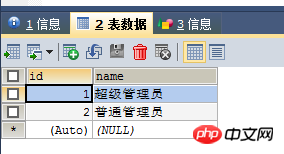
Basic structure:
##
1 #coding:Utf82 from django.db import models3 4 class userinfo(models.Model):5 #如果没有models.AutoField,默认会创建一个id的自增列6 name = models.CharField(max_length=30)7 email = models.EmailField()8 memo = models.TextField()
##Field explanation:


1 1、models.AutoField 自增列= int(11) 2 如果没有的话,默认会生成一个名称为 id 的列,如果要显示的自定义一个自增列,必须将给列设置为主键 primary_key=True。 3 2、models.CharField 字符串字段 4 必须 max_length 参数 5 3、models.BooleanField 布尔类型=tinyint(1) 6 不能为空,Blank=True 7 4、models.ComaSeparatedIntegerField 用逗号分割的数字=varchar 8 继承CharField,所以必须 max_lenght 参数 9 5、models.DateField 日期类型 date10 对于参数,auto_now =True则每次更新都会更新这个时间;auto_now_add 则只是第一次创建添加,之后的更新不再改变。11 6、models.DateTimeField 日期类型 datetime12 同DateField的参数13 7、models.Decimal 十进制小数类型= decimal14 必须指定整数位max_digits和小数位decimal_places15 8、models.EmailField 字符串类型(正则表达式邮箱)=varchar16 对字符串进行正则表达式17 9、models.FloatField 浮点类型= double18 10、models.IntegerField 整形19 11、models.BigIntegerField 长整形20 integer_field_ranges ={21 'SmallIntegerField':(-32768,32767),22 'IntegerField':(-2147483648,2147483647),23 'BigIntegerField':(-9223372036854775808,9223372036854775807),24 'PositiveSmallIntegerField':(0,32767),25 'PositiveIntegerField':(0,2147483647),26 }27 12、models.IPAddressField 字符串类型(ip4正则表达式)28 13、models.GenericIPAddressField 字符串类型(ip4和ip6是可选的)29 参数protocol可以是:both、ipv4、ipv630 验证时,会根据设置报错31 14、models.NullBooleanField 允许为空的布尔类型32 15、models.PositiveIntegerFiel 正Integer33 16、models.PositiveSmallIntegerField 正smallInteger34 17、models.SlugField 减号、下划线、字母、数字35 18、models.SmallIntegerField 数字36 数据库中的字段有:tinyint、smallint、int、bigint37 19、models.TextField 字符串=longtext38 20、models.TimeField 时间 HH:MM[:ss[.uuuuuu]]39 21、models.URLField 字符串,地址正则表达式40 22、models.BinaryField 二进制41 23、models.ImageField图片42 24、models.FilePathField文件Parameter explanation:


1 1、null=True 2 数据库中字段是否可以为空 3 2、blank=True 4 django的Admin中添加数据时是否可允许空值 5 3、primary_key =False 6 主键,对AutoField设置主键后,就会代替原来的自增 id 列 7 4、auto_now 和 auto_now_add 8 auto_now 自动创建---无论添加或修改,都是当前操作的时间 9 auto_now_add 自动创建---永远是创建时的时间10 5、choices11 GENDER_CHOICE =(12 (u'M', u'Male'),13 (u'F', u'Female'),14 )15 gender = models.CharField(max_length=2,choices = GENDER_CHOICE)16 6、max_length17 7、default 默认值18 8、verbose_name Admin中字段的显示名称19 9、name|db_column 数据库中的字段名称20 10、unique=True 不允许重复21 11、db_index =True 数据库索引22 12、editable=True 在Admin里是否可编辑23 13、error_messages=None 错误提示24 14、auto_created=False 自动创建25 15、help_text 在Admin中提示帮助信息26 16、validators=[]27 17、upload-to
##Parameter explanation
Perform data operations
object
s.all()models.UserInfo.objects.all().values('user') #Only Get the user column
list
('id','user') #Get the id and user column and generate a listmodels.UserInfo.objects.get(id=1) #Get the data with id=1 models.UserInfo.objects.get(user='rose') #Get user='rose' data
obj = models.UserInfo(user='rose',pwd='123456')
obj.save()
or
dic = {'user':'rose','pwd':'123456'}
models.UserInfo.objects.create(**dic)
Delete:
()
## Change:
obj = models.UserInfo.objects.get(user='rose')
##
1 # 获取个数 2 # 3 # models.Tb1.objects.filter(name='seven').count() 4 # 大于,小于 5 # 6 # models.Tb1.objects.filter(idgt=1) # 获取id大于1的值 7 # models.Tb1.objects.filter(idlt=10) # 获取id小于10的值 8 # models.Tb1.objects.filter(idlt=10, idgt=1) # 获取id大于1 且 小于10的值 9 # in10 #11 # models.Tb1.objects.filter(idin=[11, 22, 33]) # 获取id等于11、22、33的数据12 # models.Tb1.objects.exclude(idin=[11, 22, 33]) # not in13 # contains14 #15 # models.Tb1.objects.filter(namecontains="ven")16 # models.Tb1.objects.filter(nameicontains="ven") # icontains大小写不敏感17 # models.Tb1.objects.exclude(nameicontains="ven")18 # range19 #20 # models.Tb1.objects.filter(idrange=[1, 2]) # 范围bettwen and21 # 其他类似22 #23 # startswith,istartswith, endswith, iendswith,24 # order by25 #26 # models.Tb1.objects.filter(name='seven').order_by('id') # asc27 # models.Tb1.objects.filter(name='seven').order_by('-id') # desc28 # limit 、offset29 #30 # models.Tb1.objects.all()[10:20]31 # group by32 from django.db.models import Count, Min, Max, Sum33 # models.Tb1.objects.filter(c1=1).values('id').annotate(c=Count('num'))34 # SELECT "app01_tb1"."id", COUNT("app01_tb1"."num") AS "c" FROM "app01_tb1" WHERE "app01_tb1"."c1" = 1 GROUP BY "app01_tb1"."id"

2. Detailed explanation of common fields
auto_now = True: This time will be updated every time it is updatedauto_now_add is only created and added for the first time, and subsequent updates will not change.
1 class UserInfo(models.Model):2 name = models.CharField(max_length=32)3 ctime = models.DateTimeField(auto_now=True)4 uptime = models.DateTimeField(auto_now_add=True)
1 from app01 import models2 def home(request):3 models.UserInfo.objects.create(name='yangmv')4 after = models.UserInfo.objects.all()5 print after[0].ctime6 return render(request, 'app01/home.html')
Modification of the table structure
1 from django.db import models2 3 # Create your models here.4 class UserInfo(models.Model):5 name = models.CharField(max_length=32)6 ctime = models.DateTimeField(auto_now=True)7 uptime = models.DateTimeField(auto_now_add=True)8 email = models.EmailField(max_length=32,null=True)9 email1 = models.EmailField(max_length=32,default='rose@qq.com')
执行makemigrations, migrate 后。老数据会自动应用新增加的规则
ip = models.GenericIPAddressField(protocol="ipv4",null=True,blank=True) img = models.ImageField(null=True,blank=True,upload_to="upload")
选择下拉框 choices
1 class UserInfo(models.Model):2 USER_TYPE_LIST = (3 (1,'user'),4 (2,'admin'),5 )6 user_type = models.IntegerField(choices=USER_TYPE_LIST,default=1)
一对多:models.ForeignKey(其他表)
多对多:models.ManyToManyField(其他表)
一对一:models.OneToOneField(其他表)
应用场景:
一对多:当一张表中创建一行数据时,有一个单选的下拉框(可以被重复选择)
例如:创建用户信息时候,需要选择一个用户类型【普通用户】【金牌用户】【铂金用户】等。
多对多:在某表中创建一行数据是,有一个可以多选的下拉框
例如:创建用户信息,需要为用户指定多个爱好
一对一:在某表中创建一行数据时,有一个单选的下拉框(下拉框中的内容被用过一次就消失了
例如:原有含10列数据的一张表保存相关信息,经过一段时间之后,10列无法满足需求,需要为原来的表再添加5列数据
1 from django.db import models 2 3 4 # Create your models here. 5 class UserType(models.Model): 6 name = models.CharField(max_length=50)
7 class UserInfo(models.Model): 8 username = models.CharField(max_length=50) 9 password = models.CharField(max_length=50)10 email = models.EmailField()11 user_type = models.ForeignKey('UserType')这是UserInfo表,可以通过外键,对应到UserType表的ID

这是User_Type表的数据

1 from django.db import models 2 3 4 # Create your models here. 5 class UserType(models.Model): 6 name = models.CharField(max_length=50)
7 class UserInfo(models.Model): 8 username = models.CharField(max_length=50) 9 password = models.CharField(max_length=50)10 email = models.EmailField()11 user_type = models.ForeignKey('UserType')
12 class UserGroup(models.Model):13 GroupName = models.CharField(max_length=50)14 user = models.ManyToManyField("UserInfo")Django model会自动创建第3张关系表,用于对应UserInfo_id 和UserGroup_id
UserInfo表如上所示:
UserGroup表

Django自动生成的对应关系表

userinfo_id = 1 为 Boss,属于1(用户组A)
1 from django.db import models 2 3 4 # Create your models here. 5 class UserType(models.Model): 6 name = models.CharField(max_length=50)
7 class UserInfo(models.Model): 8 username = models.CharField(max_length=50) 9 password = models.CharField(max_length=50)10 email = models.EmailField()11 user_type = models.ForeignKey('UserType')
12 class UserGroup(models.Model):13 GroupName = models.CharField(max_length=50)14 user = models.ManyToManyField("UserInfo")
15 class Admin(models.Model):16 Address = models.CharField()17 user_info_address = models.OneToOneField('UserInfo')
The above is the detailed content of Django Model operation. For more information, please follow other related articles on the PHP Chinese website!




